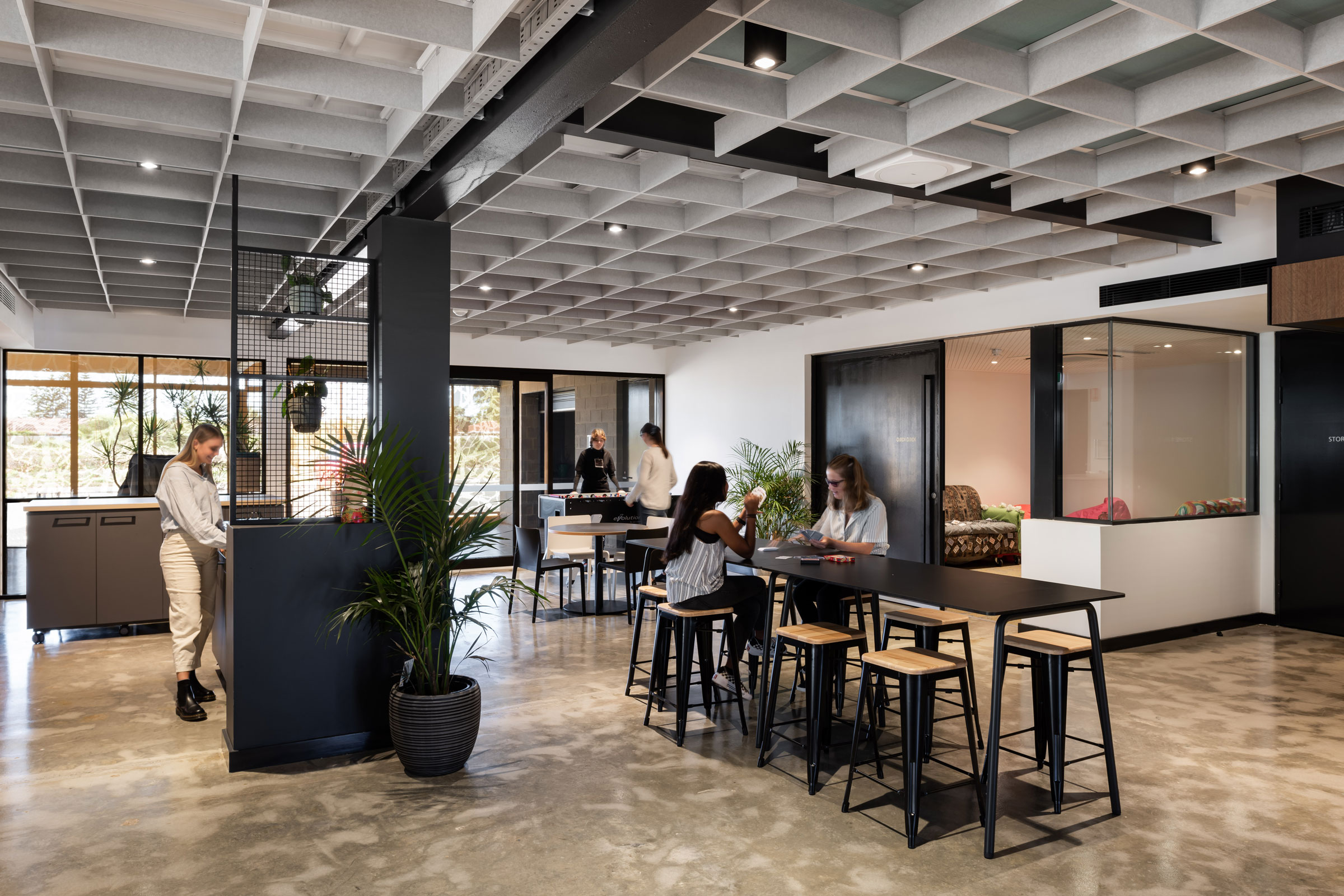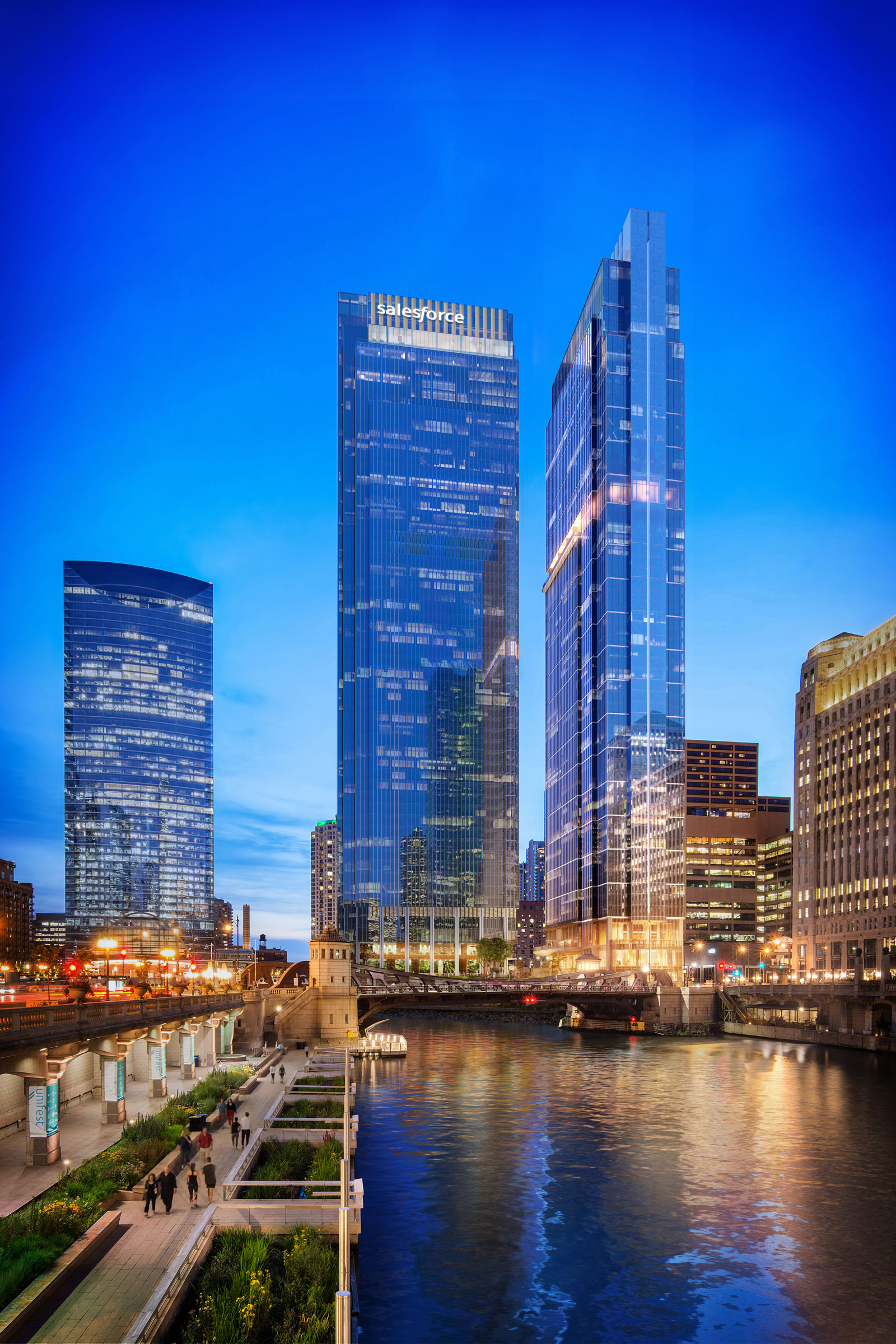Story at a glance:
- Healthy materials, acoustic treatments, and more are changing the way we design office spaces.
- Pelli Clarke & Partners designs quiet zones and collaborative areas inside new offices like the one at Salesforce.
- Autex Acoustics makes both “head down” and collaborative work time easier with flexible acoustic solutions.
“We spend a ton of time inside buildings,” says Relina Bulchandani, executive vice president of real estate and workplace services at Salesforce—the massive American cloud-based software company based in San Francisco. Often the buildings we spend so much time in are our workplaces, and Salesforce is constantly thinking about what that means for both their employees and the environment.
One of Salesforce’s newest projects is its Chicago tower—a 60-story office building designed by Pelli Clarke & Partners and opened in spring 2023. Bulchandani says Salesforce continues to think through how it lays out space for employees to make for the best experience. The Chicago project in particular pays close attention to that—with a design that progresses from quieter to louder and more collaborative spaces. “We’re creating libraries and different zones that are separated acoustically,” Bulchandani says.
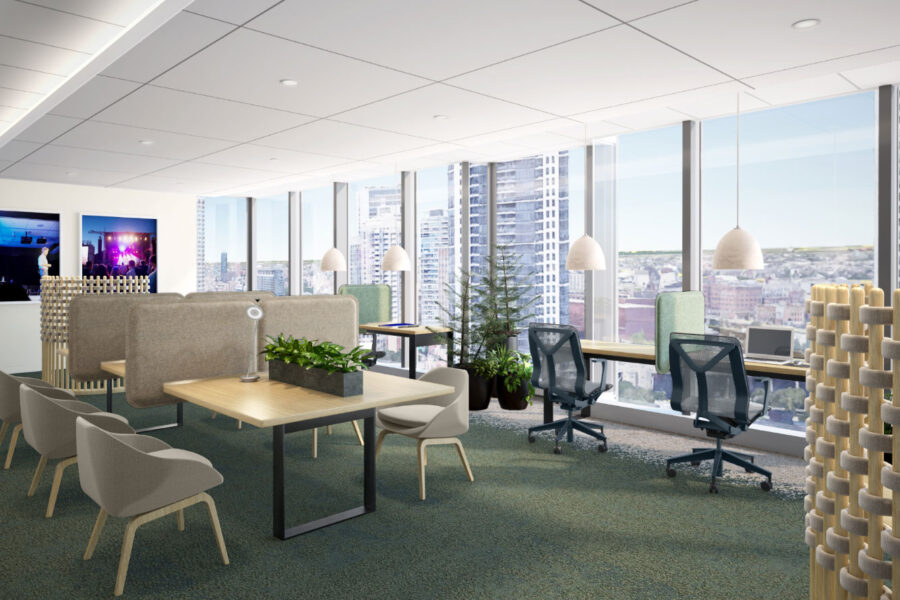
The library space in Salesforce Tower Chicago will provide a variety of individual work settings, including natural light at some seats or, if employees choose, darker spaces with tactile surfaces and task lighting for user control. Rendering courtesy of Salesforce
Designing quiet zones and collaborative areas was done to support the neurodiverse population initially, but it was soon clear that everyone benefits from a diversity of spaces, Bulchandani says. “It’s really making sure that we can support many different employees who come in—that they have spaces that really work for them.”
Separating spaces properly—with the right acoustic controls—can be a challenge in some large offices, and collaboration is only also expected to grow across most offices. Salesforce expects work to continue to move in that direction; in their new offices they’re increasing collaborative spaces from 40 to 60%.
In many cases a return to the office means having to adjust to distractions, says Antonio Holguin, sustainability lead for Autex Acoustics, a leading designer and supplier of innovative acoustic in the US. “Whether we were working by ourselves at home or working with other people in the house in a different room, we’re going from a place of not having to worry about a lot of office noise into an open concept space where you may have 10 conversations going on around you. It’s a big shock,” Holguin says.
He says more offices are working to reconfigure and redesign their spaces to accommodate employees. Some have had to downsize or share space, and he says Autex is seeing a lot more common areas in designs. “All of that really has contributed to a big demand for acoustic solutions.”
- Salesforce Tower Chicago is a 60-story tower on the Chicago River. Photo courtesy of Salesforce
- The new Salesforce Tower designed by Pelli Clarke & Partners opened in Spring 2023. Photo courtesy of Salesforce
Bulchandani has seen firsthand the effects that proper acoustics can have, as some people work better in quiet areas and need more “head down” time, while others crave a livelier space. “We’re trying to really think about our spaces—does it work for our employees? Does it meet the diverse needs of employees?”
Holguin says one way to ensure everyone is more comfortable is to pair Autex’s baffle systems with their Quietspace wall panel. This combination is one of Autex’s best sellers as it gives designers both vertical and horizontal coverage for better sound absorption. “Designers tend to gravitate toward those because they are very easy to implement into their designs but also customizable to fit their design vision.” Solutions like these work great in commercial spaces with large open areas like conference rooms, foyers, and open offices, he says.
Bulchandani says the modern office also needs to be enticing, healthy, and fun, with natural light and biophilic design elements. “People spend a lot of time at work, right? How do we have more access to plants and to healthy materials?”
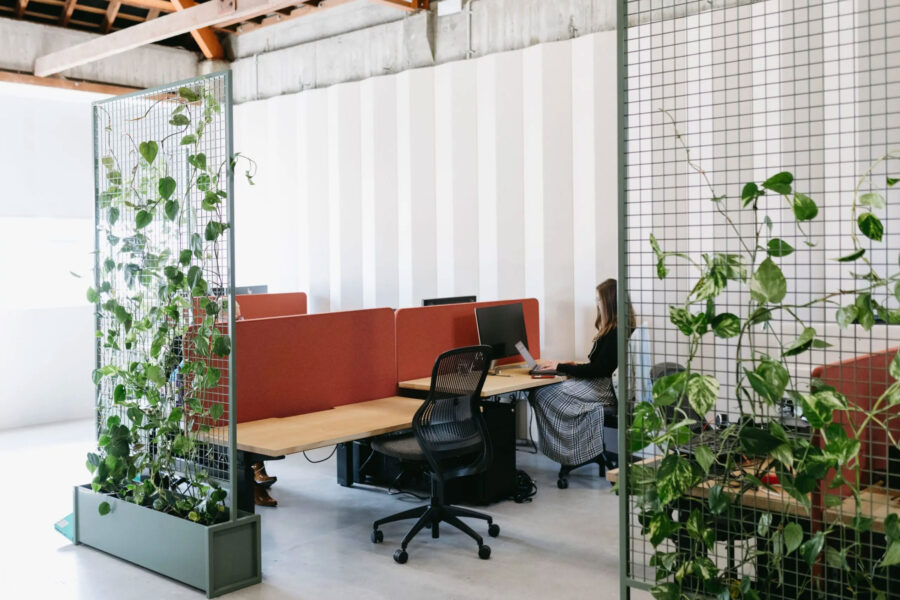
Autex’s contributions to well-designed, acoustically comfortable co-working spaces help even diverse spaces meet individual working needs. Vicinity Desk Screens and Lanes are seen here. Photo courtesy of Autex Acoustics
The healthiest offices are designed using sustainable materials—low or no VOC and with no Red List ingredients, for example. All of Salesforce’s offices since 2016 have been built to meet LEED Gold or Platinum standards, and the company is also working toward being entirely zero carbon, Bulchandani says. Its San Francisco Tower, designed by Pelli Clarke & Partners and completed in 2018, is a great example of sustainable design down to the last detail—the carpet, paint, custom HVAC, and more. The project saves 30,000 gallons of fresh water each day by blackwater recycling, 75% of occupied spaces receive natural daylight, and fresh air reaches each floor from intake louvers in the facade.
Autex Acoustics solutions are also free of Red List chemicals. Holguin takes pride in the fact that the company makes their own acoustic panels, unlike a lot of their competitors. They are both durable and minimize waste in their production. All of their products include at least 60% recycled post-consumer PET. You can download Autex’s full sustainability report online.
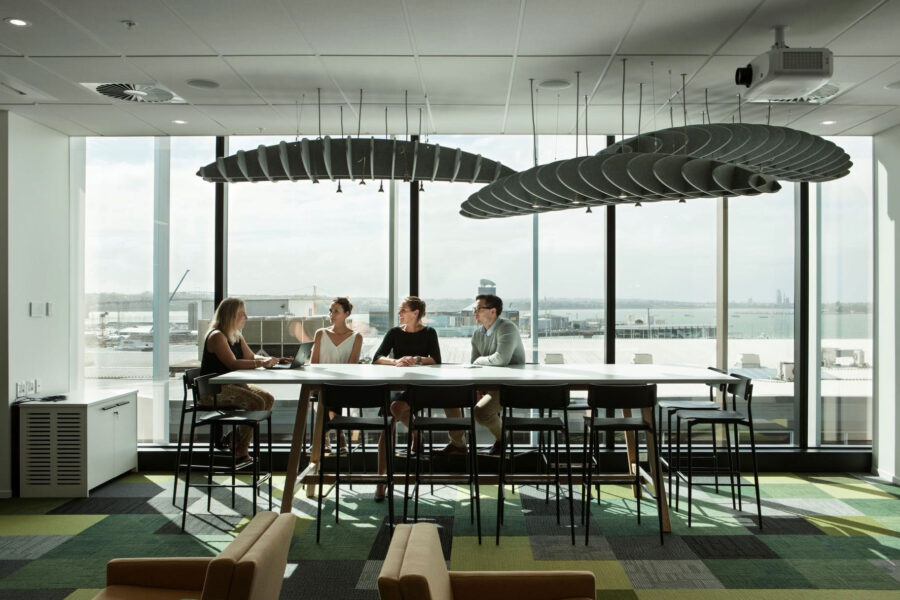
Photo courtesy of Autex Acoustics
Autex is carbon neutral in everything it does, but healthy goes beyond materials and translates to well-being, too. Autex Acoustics products are designed to reduce and control reverberated noise and echo in interior spaces—and noise has been proven in studies again and again to significantly harm well-being. Autex’s Quietspace panel is engineered to absorb a minimum of 85% of sound energy, while their lightweight Cube panels absorb excess reverberation.
Just like they did with Quietspace, Autex’s New Zealand design team is constantly innovating with smart products that solve problems. “It’s not just going to be a new fancy design for the sake of it. They’re really focused on innovation within the acoustic space.” That innovation centers around developing new carbon neutral product lines.
For biophilic options, Autex’s print solutions are also in demand in today’s offices. “People want to come back to a space that’s not only inviting but feels luxurious or fun,” Holguin says. “We’ve been seeing a lot of demand for our printed baffles or printed panels.” This includes their Acoustic Timber, which looks like wood, and their new Stone collection. “We’re providing the visual of a luxury material for much less cost, and you get the sound absorption,” he says. “We are helping people curate higher-end fit outs that are not only sustainable because we’re using post-consumer plastic but it’s also sound absorbent. It’s the best of both worlds.”
Autex’s internal design team works with project architects and designers from a project’s inception to make sure they get exactly the acoustic solution they need. They excel at providing custom solutions, too, for anyone who doesn’t want an “off the shelf” product. “Designers are often scared of the word custom because they think we’re adding lead time or cost,” Holguin says. “For us it’s part of the field we’re in; we can make these 4-by-8-foot panels into anything. We’ll have our design team work with the client to make sure all the hardware is correct and that we know how to install it. And we look at what they’re trying to do to get the most yield out of our sheets so it’s not a wasteful design.”
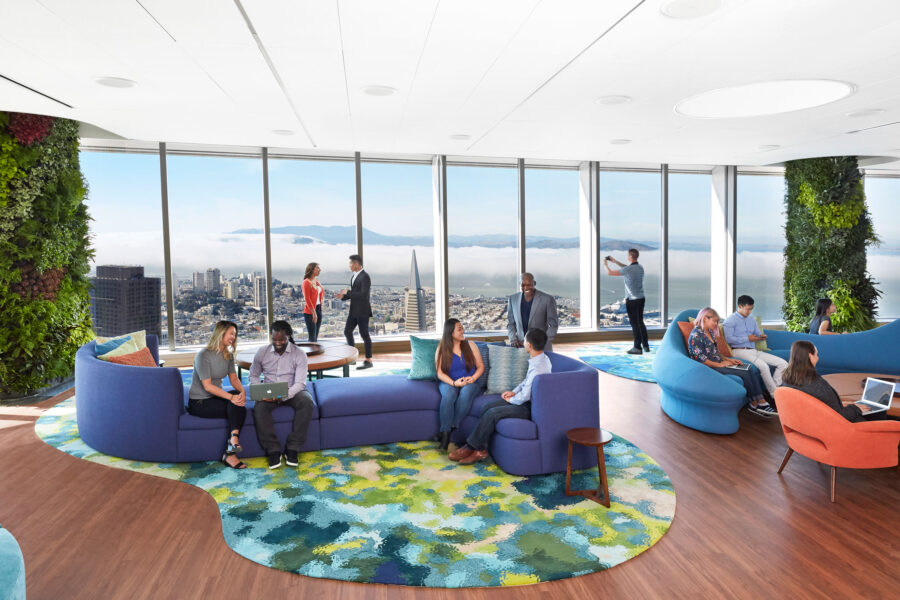
The Ohana Floor on the 61st floor of 415 Mission Street, Salesforce’s San Francisco Tower, can accommodate up to 250 guests. Photo courtesy of Salesforce
Beyond acoustics, Bulchandani is also concerned with people’s overall experience of a space—how do you design to be more inclusive, for example? She references UC Berkeley Professor John A. Powell, an equity and inclusion expert and law professor. “He was talking about how people of color have to constantly code switch in their work environments,” she says. “How do we create spaces that people feel really welcome in so they can bring their authentic selves to work?”

Salesforce’s training rooms allow teams to come together to foster learning, development, collaboration, and productivity. Photo courtesy of Salesforce
Salesforce is pushing for more flexibility in the modern office across the board. “We all have to re-recruit employees to come back into the offices—not just to come in but to come in consistently,” she says. “I want employees to have agency and choice. You find the right space at the right time for the right activity.” But what do the people themselves really want out of an office? And what makes an office healthy? Salesforce has been surveying people on that most recently for months, and those conversations and interviews are ongoing. One thing, she says, is for certain, Bulchandani says. “Healthy, sustainable spaces attract folks.”

